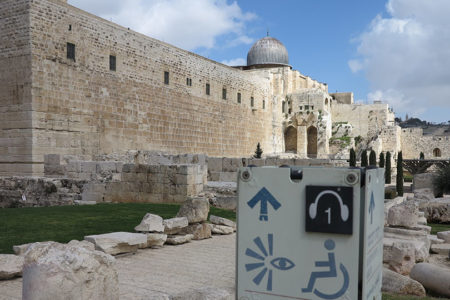Discovering Our Biblical Roots in Modern Israel
Israel is a thoroughly modern country with major cities, modern highways, and mass transit. But have the picturesque sites and ancient customs from the Bible vanished amid all the urban sprawl? Thankfully, the answer is no. While some views and vistas have disappeared, many remain. And those visiting Israel today actually have opportunities to connect with their biblical roots in ways that weren’t possible a few decades ago.
I’ve watched Israel develop and change over the 30 years I’ve been traveling there, and in some places progress has resulted in the loss of those “Kodak moments” that helped illustrate the Bible. I still sigh as I drive past a modern town that now covers the hillside where a natural cave served as a sheepfold that helped bring John 10 to life. Yet for every spot that has disappeared, new sites have been uncovered.
In fact, now is the best time for those searching out their biblical roots to travel to Israel. And I say that for three practical reasons.
(1) Increased Availability of Sites
My first trips to Israel were with student groups. We visited sites not accessible to most tourists. In those days visiting Mount Arbel meant driving along an unpaved road through a Jewish farming community and then hiking nearly a mile up a dirt path. Today the site is a national park. The road is paved, and the walk is less than a quarter mile. As a result, more people can now enjoy that unforgettable overlook of the Sea of Galilee.
A few decades ago, visiting Beth-Shean meant driving to the ruins of the Roman theatre and staring out over a grassy field to the hill where the Old Testament city once sat. Today tourists walk from the theatre toward the hill on an ancient Roman street, visit the bath complex, and stand beside columns toppled in a massive earthquake that destroyed this once-great city. Beth-Shean is Israel’s Pompeii, and the ruins (still being uncovered) are fascinating.
Visitors to the Golan Heights today can drive up into Mount Bental, an extinct volcanic crater that houses a deactivated Israeli army base. The site, opened to the public only a few years ago, provides an unparalleled view of Mount Hermon and Syria—and helps visitors truly understand the geographical significance of the Golan Heights.
Even Jerusalem has more available sites. After Israel reunified the city in 1967, archaeologists finally had an opportunity to do widespread excavations there. What they have uncovered is simply astounding. Now you can visit the Southern Steps that once led up to the Temple Mount, walk on the street that extended from the Temple to the Pool of Siloam, or snake your way through a Canaanite tunnel that diverted water from the Gihon Spring into the Kidron Valley—quite possibly the “water shaft” Joab traversed to capture the city for David (2 Sam. 5:8).
The list of new sites throughout Israel is impressive, and it continues to grow. The water tunnel at Beersheba. The gate complex and high place at Tel Dan. The first-century Pool of Siloam in Jerusalem. These are all relatively recent additions to the growing list of places open to tourists. And all are worth seeing!
(2) Increased Accessibility of Sites
Biblical sites are not only more numerous, they’re also more accessible. My first visit to the Bell Caves at Beit Guvrin was a bus ride up a dusty road, followed by a strenuous climb over a high embankment. And as for restrooms? “Men to the right and women to the left.” Today the site is a national park, and a paved road leads to well-marked paths and modern restrooms.
The Tel Dan Nature Preserve is an amazing slice of Israel that surprises most visitors with its rushing water and thick vegetation. A visit in the past required the nimbleness of a mountain goat, but today a wooden walkway with handrails makes at least part of the site accessible for the less mobile.
The land of Israel is hilly and rocky, and many sites still pose challenges. But Israel is doing much to make those sites more user-friendly. Places like Masada are becoming more wheelchair accessible, and even the Garden Tomb now boasts wheelchair ramps. Mobility-impaired visitors now have greater access to sites than at any time in the past.
(3) Increased Visualization
Availability and accessibility are important. But being able to reach a site doesn’t necessarily mean visitors will understand its biblical significance. I remember countless times when people would bring me their pictures from Israel and ask, “Now, what am I looking at here?”
For decades the best tool for understanding Jerusalem at the time of Jesus was the Model of Jerusalem at the Holy Land Hotel. The model has now been moved to the Israel Museum. And the best news is that it’s being joined by a host of other efforts to visualize sites and discoveries throughout the land. In fact, one of the greatest changes in Israel over the past few years has been the addition of signage, models, movies, and other immersive experiences to help visitors visualize the sites and grasp their biblical and historical significance.
These new signs and models are helping to bring many sites to life. At some sites, like Megiddo, the improvement is as simple as a sculpture of a horse next to a stone manger. At other sites it might be the addition of a Bible verse, like the one at the high place at Tel Dan recounting Jeroboam’s construction of a temple there.
More high-tech changes appeal to a younger generation. The short film near the entrance to the Southern Steps in Jerusalem helps visualize the grandeur of Herod’s Temple. The 3-D movie at the City of David tells the story of Jerusalem in a biblically accurate and visually compelling manner. And the new film at Caesarea enables visitors to trace the history of the site from Herod the Great until today.
Perhaps the greatest impact on visitors today is taking place in the immersive experiences now part of so many trips to Israel. The old boat ride across the Sea of Galilee in white tour boats has been replaced with outsized replicas of boats from the time of Jesus—complete with demonstrations of casting a fishing net into the water.
Spending a few hours at Nazareth Village is a journey back to Christ’s day. You can watch a farmer plow, plant, and harvest; see a shepherd watching over his flock; visit a first-century carpenter’s shop; look into a cistern; or gaze at the feeble light given off by a first-century oil lamp.
These are visceral experiences that make the images and illustrations of the Bible come alive. In the same way, Old Testament agricultural imagery takes on new meaning after walking through the Biblical Landscape Reserve at Neot Kedumim. Then you understand what the Bible means when it says wise king Solomon “spoke of trees, from the cedar tree of Lebanon even to the hyssop that springs out of the wall” (1 Ki. 4:33).
Can visitors to Israel today still uncover their biblical roots? The answer is a resounding yes. Today more than ever, the storied locations of the Bible await your arrival. But make sure you prepare yourself before you go. Read up on the sites you will visit. Take along a good digital camera and additional memory cards. And be prepared to have your knowledge of the Bible increase exponentially as you encounter the land where it all took place.






